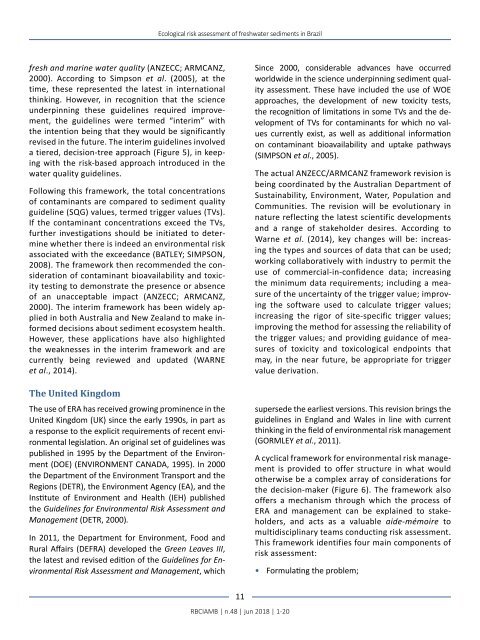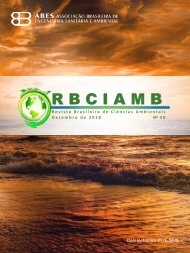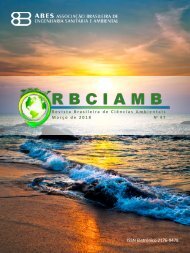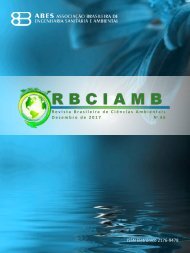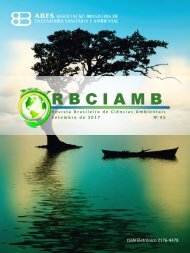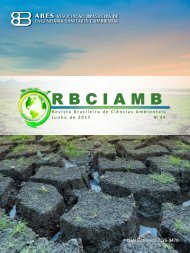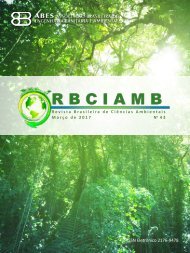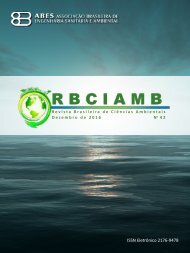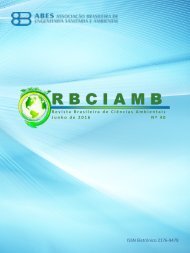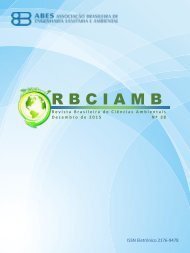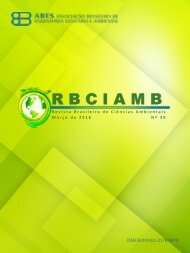Edição 48 RBCIAMB
Create successful ePaper yourself
Turn your PDF publications into a flip-book with our unique Google optimized e-Paper software.
Ecological risk assessment of freshwater sediments in Brazil<br />
fresh and marine water quality (ANZECC; ARMCANZ,<br />
2000). According to Simpson et al. (2005), at the<br />
time, these represented the latest in international<br />
thinking. However, in recognition that the science<br />
underpinning these guidelines required improvement,<br />
the guidelines were termed “interim” with<br />
the intention being that they would be significantly<br />
revised in the future. The interim guidelines involved<br />
a tiered, decision-tree approach (Figure 5), in keeping<br />
with the risk-based approach introduced in the<br />
water quality guidelines.<br />
Following this framework, the total concentrations<br />
of contaminants are compared to sediment quality<br />
guideline (SQG) values, termed trigger values (TVs).<br />
If the contaminant concentrations exceed the TVs,<br />
further investigations should be initiated to determine<br />
whether there is indeed an environmental risk<br />
associated with the exceedance (BATLEY; SIMPSON,<br />
2008). The framework then recommended the consideration<br />
of contaminant bioavailability and toxicity<br />
testing to demonstrate the presence or absence<br />
of an unacceptable impact (ANZECC; ARMCANZ,<br />
2000). The interim framework has been widely applied<br />
in both Australia and New Zealand to make informed<br />
decisions about sediment ecosystem health.<br />
However, these applications have also highlighted<br />
the weaknesses in the interim framework and are<br />
currently being reviewed and updated (WARNE<br />
et al., 2014).<br />
The United Kingdom<br />
The use of ERA has received growing prominence in the<br />
United Kingdom (UK) since the early 1990s, in part as<br />
a response to the explicit requirements of recent environmental<br />
legislation. An original set of guidelines was<br />
published in 1995 by the Department of the Environment<br />
(DOE) (ENVIRONMENT CANADA, 1995). In 2000<br />
the Department of the Environment Transport and the<br />
Regions (DETR), the Environment Agency (EA), and the<br />
Institute of Environment and Health (IEH) published<br />
the Guidelines for Environmental Risk Assessment and<br />
Management (DETR, 2000).<br />
In 2011, the Department for Environment, Food and<br />
Rural Affairs (DEFRA) developed the Green Leaves III,<br />
the latest and revised edition of the Guidelines for Environmental<br />
Risk Assessment and Management, which<br />
Since 2000, considerable advances have occurred<br />
worldwide in the science underpinning sediment quality<br />
assessment. These have included the use of WOE<br />
approaches, the development of new toxicity tests,<br />
the recognition of limitations in some TVs and the development<br />
of TVs for contaminants for which no values<br />
currently exist, as well as additional information<br />
on contaminant bioavailability and uptake pathways<br />
(SIMPSON et al., 2005).<br />
The actual ANZECC/ARMCANZ framework revision is<br />
being coordinated by the Australian Department of<br />
Sustainability, Environment, Water, Population and<br />
Communities. The revision will be evolutionary in<br />
nature reflecting the latest scientific developments<br />
and a range of stakeholder desires. According to<br />
Warne et al. (2014), key changes will be: increasing<br />
the types and sources of data that can be used;<br />
working collaboratively with industry to permit the<br />
use of commercial-in-confidence data; increasing<br />
the minimum data requirements; including a measure<br />
of the uncertainty of the trigger value; improving<br />
the software used to calculate trigger values;<br />
increasing the rigor of site-specific trigger values;<br />
improving the method for assessing the reliability of<br />
the trigger values; and providing guidance of measures<br />
of toxicity and toxicological endpoints that<br />
may, in the near future, be appropriate for trigger<br />
value derivation.<br />
supersede the earliest versions. This revision brings the<br />
guidelines in England and Wales in line with current<br />
thinking in the field of environmental risk management<br />
(GORMLEY et al., 2011).<br />
A cyclical framework for environmental risk management<br />
is provided to offer structure in what would<br />
otherwise be a complex array of considerations for<br />
the decision-maker (Figure 6). The framework also<br />
offers a mechanism through which the process of<br />
ERA and management can be explained to stakeholders,<br />
and acts as a valuable aide-mémoire to<br />
multidisciplinary teams conducting risk assessment.<br />
This framework identifies four main components of<br />
risk assessment:<br />
• Formulating the problem;<br />
11<br />
<strong>RBCIAMB</strong> | n.<strong>48</strong> | jun 2018 | 1-20


